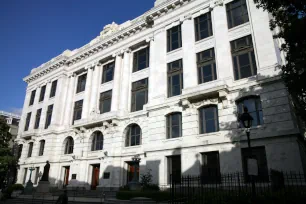The French Quarter has a unique architectural cohesiveness, with its rows of residential houses from the seventeenth and eighteenth centuries. One significant exception is the Supreme Court Building, an imposing white granite structure in the Beaux-Arts style.

But despite its atypical architecture and massive size, the Supreme Court Building is one of the most beautiful buildings in the French Quarter.
Construction
In the early twentieth century, the French Quarter was in decline and many buildings were dilapidated. So when a whole block of historic houses were demolished to make way for a new court building, there was little protest. Construction of this monumental Beaux-Arts building – the largest such building in Louisiana – started in 1908. It opened in 1910 as the New Courthouse Building and housed the Louisiana Supreme Court and the Orleans Civil District Court.
Renovation

In 1958 the Supreme Court moved to the modern Duncan Plaza Civic Complex in the Central Business District. For some time the court building was used for government offices, but it was soon vacated and fell into disrepair. In the 1980s, plans were made to move the Supreme court back to its former premise in the French Quarter. Restoration only started in the 1990s, and it would take until May 2004 before the Supreme Court moved back to the historic courthouse in the upper French Quarter.
Architecture
Despite the French roots of the Beaux-Arts style, there are very few such buildings in Louisiana, and the Supreme Court Building is by far the best example of this architecture style in New Orleans. The granite and marble building has a magnificent façade, partially hidden behind palm trees. The entrance at Royal Street is marked by round arched windows topped with colossal Ionic pilasters. In front of the entrance stands a monument of Edward Douglas White, a US senator and, from 1910 until 1921, head of the United States federal court.

